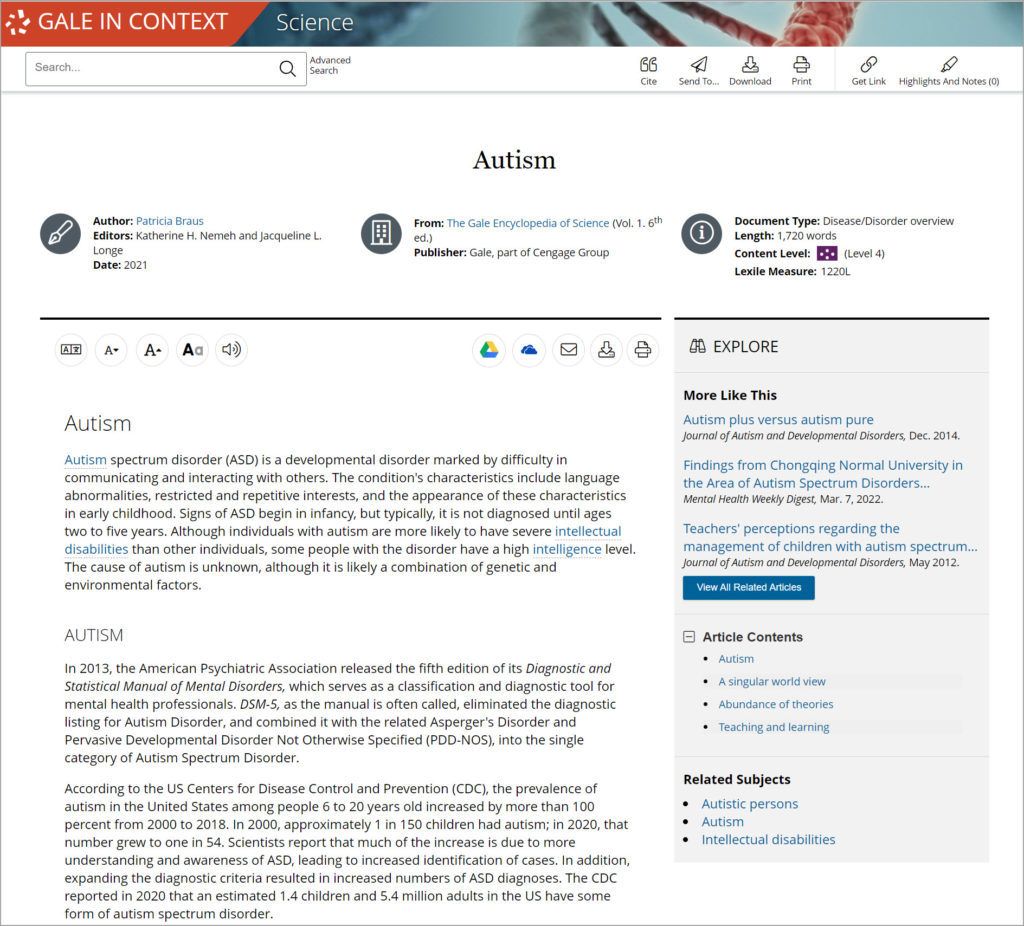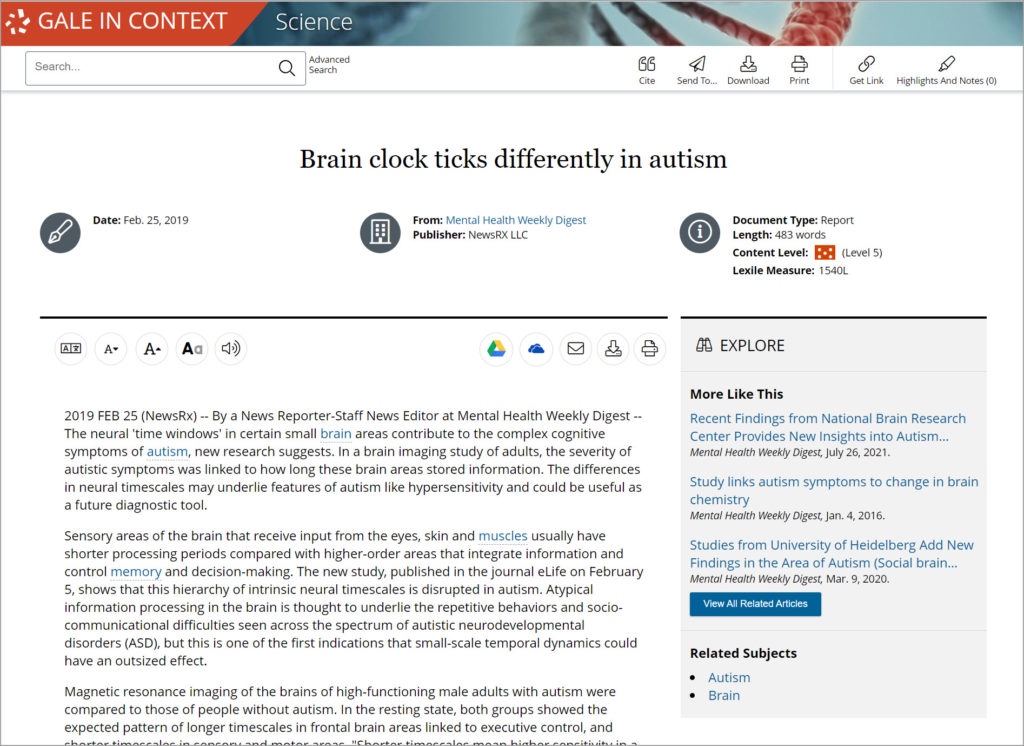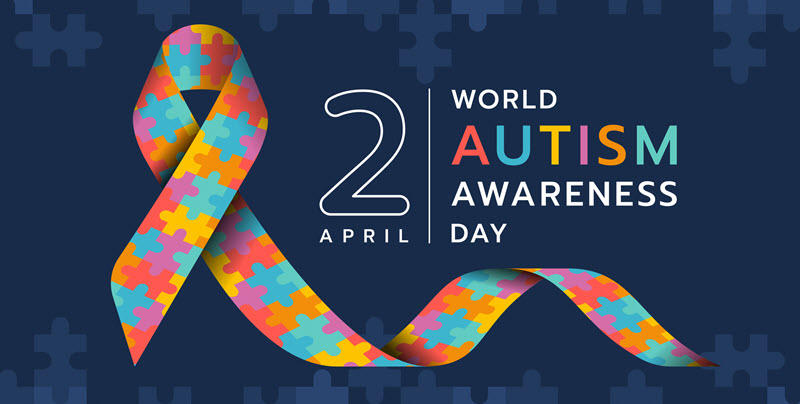| By Gale Staff |
In 2007, the United Nations (UN) declared April 2 as World Autism Awareness Day. The UN strives to promote equal rights and opportunities for all people, and World Autism Awareness Day is an opportunity to encourage respect for and celebrate those with Autism Spectrum Disorder (ASD).
Autism is a neurological condition that manifests in young children. This disorder can affect any population, regardless of gender or race, and ASD can present in several ways. Typically, individuals with autism approach learning and social interactions differently than people with neurotypical brain function. These differences sometimes lead others to discriminate against people with autism, and negative or misinformed perceptions limit opportunities for those with ASD.
By shedding light on this underserved population and providing accurate information about autism, educators can help create a more inclusive classroom and community. This April, use the autism portal in Gale In Context: Science for vetted information on ASD and find creative ways to celebrate World Autism Awareness Day in your classroom.
Explore Gale’s Autism Portal
Gale In Context: Science features an expert collection of content for you and your students to use to better understand autism. Begin with the high-level summary in Science, which outlines the disorder’s history and medical theories. You’ll also find highlighted key terms and a collection of recommended websites for deeper research. From there, you can browse thousands of related resources, including academic articles, audio files, news pieces, and more. Gale’s diverse results help educators tailor their lessons accordingly. Perhaps you want to show a video that describes basic misconceptions about people with autism or have students research other developmental disorders to better understand the prevalence of neurodiverse individuals.

Engage Young Learners
One of the key features of Gale In Context: Science is the ability to adapt to your specific classroom needs. You can use Gale’s advanced search features to filter your results by content level and Lexile measure, which allows for the flexibility to curate resources by reading levels and age-appropriate content. For elementary learners, begin with a small collection of simple-to-read news articles and audio files. Consider this short story from The New York Times, which shows a brief but powerful moment of understanding between the neurotypical writer and her brother with autism, or listen to the uplifting piece about a music group comprised of students with ASD.
Discussion Idea: Once you have outlined the basics of autism for your students, have them pair off into small groups to discuss how they might better support those with ASD. What are some of the challenges those with autism might face?
Create a More Inclusive Middle School Classroom
Middle school can be a difficult age. Imagine how hard it might be for someone with autism to navigate the complexities that come with being a teenager. Teachers can leverage Gale’s resources to help foster patience and respect in their classrooms. Your students can listen to a first-person interview with an individual with autism about dating. Encourage them to read a fascinating National Geographic article about the obstacles those with autism face as they become more independent adults. Everyone, no matter their neurological makeup, can resonate with these small, personal moments.
Activity Idea: Ask students to write a list of questions they have about people with autism. Have them select one and research the answer using Gale In Context: Science. Allow students to present their questions and findings.
Develop Lesson Plans for More Advanced Learning
Your high schoolers are ready for more in-depth research, and Gale’s filtering tools help them identify advanced resources for their level of study. Discuss scientific findings in autism diagnoses, brain function, and treatment. Explore data that illustrates the increased prevalence of ASD among children. Pose more complex, ethical questions—for example, how should people with autism be treated if he or she commits a crime? The autism portal housed in Gale In Context: Science features an extensive range of news and scholarly journal articles to challenge your more advanced learners.

Activity Idea: Have students perform research on a specific autism treatment or therapy. How effective and accessible is this intervention? Encourage students to back up their conclusions with articles in Gale and create a bibliography that features their resources (Gale has customizable citations below each article).
If your school doesn’t subscribe to Gale In Context: Science, request a trial to discover how our rich collections can contribute to your classroom.

